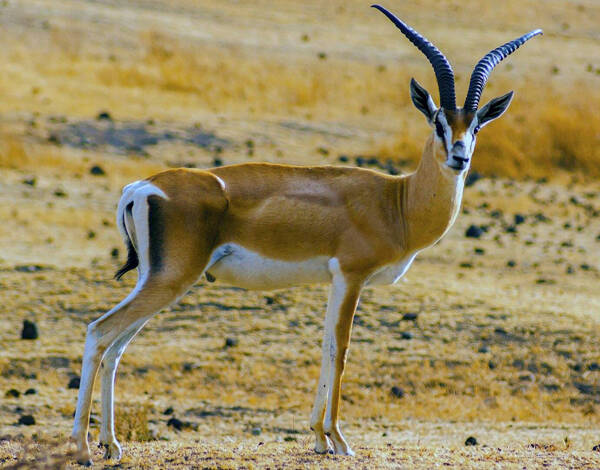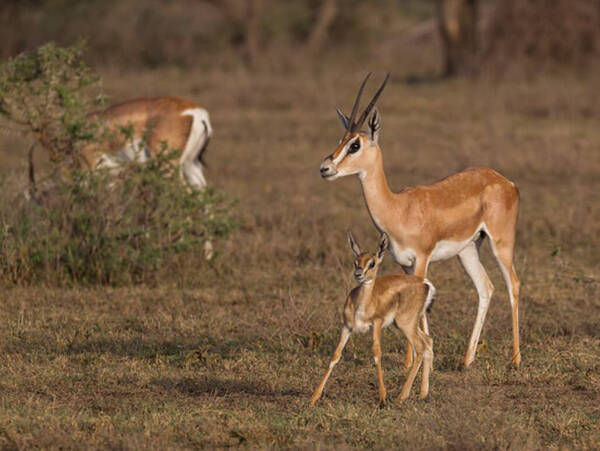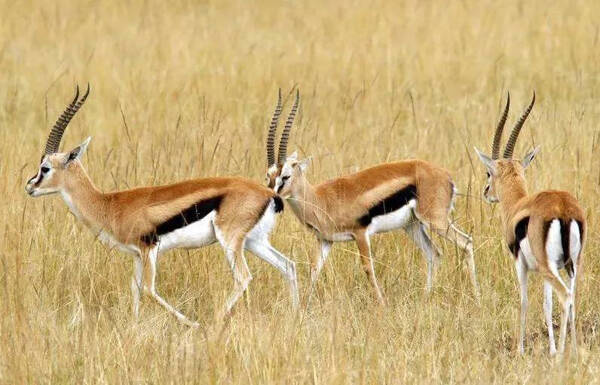Nanger granti
IUCN
LCBasic Information
Scientific classification
- name:Nanger granti
- Scientific Name:Nanger granti,Grant's gazelle, Grant's gazelle
- Outline:Ungulata
- Family:Artiodactyla Bovidae Antelope
Vital signs
- length:140-166cm
- Weight:45-65kg
- lifetime:About 15 years
Feature
It has long horns and legs, and its white rump forms a distinct rectangle with the brown back.
Distribution and Habitat
Distributed in Ethiopia, Kenya, Somalia, South Sudan, the United Republic of Tanzania and Uganda.
It lives only in eastern Africa, at altitudes from sea level to 2,500 meters above sea level. Habitats include all subtropical deserts, lowland thorn scrub, savanna woodlands, open plains and mountain grasslands up to 2,500 meters. The habitat of this species is represented by the plains and savannas of Serengeti National Park. The Goslar uses its "uniqueness of drinking water system" to survive in places that other herbivores cannot reach. Some groups even migrate to short grass plains in the dry season and to savanna woodlands in the rainy season, which is the opposite of the main migration. But most of the Goslar also share the living range in the rainy season and mix with more Thomson's gazelles. Most of the area where the Bright's subspecies lives is very dry, but they will periodically inhabit cool highland grasslands and semi-desert areas. In the southeastern
Appearance
The Goral weighs 45-65 kg and is 140-166 cm long. It is a large, light-coated antelope with long horns and legs. The white rump and brown back form a distinct rectangle with a distinct black stripe running down the thigh. Males and females are dimorphic. Males are larger than females, and their horns are longer and thicker, 50-80 cm long. In contrast to males, females have smaller horns, 30-40 cm, thin and symmetrical.
Strong physique; with legs suitable for long-distance running; there are 4 toes on the feet, but the lateral toes are more degenerate than those of deer, which are suitable for running; the incisors and canines are degenerate, but the lower incisors are retained, and the lower canines are incisorized, with three pairs of incisors tilted forward and shovel-shaped. Because they feed on relatively hard plants, the premolars and molars have high crowns, the enamel is wrinkled, and the surface forms complex tooth patterns after the crowns are worn, which is suitable for ea
Details
Grant's gazelle (scientific name: Nanger granti) is a large, light-haired antelope with three subspecies.

Grant's gazelle is migratory, and they migrate seasonally throughout their range, except in areas where there is abundant forage supply throughout the year. The species migrates in herds, and some groups establish home ranges. Herds can be divided into groups of single males and females, with males being dominant. The social hierarchy of this species can be seen in the way the males are organized when migrating. The less dominant, younger males walk in front of the herd, while the dominant males follow behind. This organization also creates equally matched opponents in fights, as nearby males are more likely to show dominance and fight each other.
The year-round range of the Goslar is about 290 square kilometers. Males in a territory mark the area with feces and urine. This marking requires the Goslar to advertise its white rump. As a result of this advertising, other Goslars show interest or withdraw. The Goslar, like many other ungulates, exhibits the anti-parasite behavior of selective defecation. They defecate in specific places to keep parasites associated with the feces pile away from other members of the herd. In addition, the Goslar will also avoid foraging in the place where they defecate. Gosaurus communicate through territorial markings made with urine and feces, sex pheromones, and visual displays. They communicate the presence of predators through alarm postures, alarm calls, and markings.
When confronting other territorial males, males may show their dominance by raising their necks and tilting their horns slightly. The second way they display dominance is by fighting. When two males approach each other to fight, they quickly move their heads down and toward the other as one tries to throw the other off balance. Fighting shows the strength of the competitors' neck muscles.

As an anti-predator behavior, the Gesaurus uses postures to sound alarms, alarm calls, and stamping sounds as signals to the presence of predators nearby. They avoid areas with high predator density and avoid waterholes, where carnivores are plentiful. They also engage in coordinated defense to protect vulnerable young antelopes, and when young are captured by predators, females may resist, teaming up with other females to fiercely defend the kidnapped young. This defense often drives the predator away, leaving the young unharmed.
A large portion of the Gudrun's gazelle's diet consists of plant leaves and stems. Living in an arid environment, water conservation and water use are essential for survival. While Thomson's gazelles use evaporative cooling as a method of lowering their body temperature, Gudrun's gazelles allow their body temperature to rise with rising temperatures, and when temperatures drop, they lose heat to the surrounding air. At night, they may also eat leaves, which contain more moisture during the cool nighttime hours.
When a female Gudrun's gazelle is in estrus, her urine contains sex pheromones that signal her reproductive status to males. To detect these, the male approaches and sniffs the air with his lips and nose to detect the presence of sex pheromones. If pheromones are detected, the male actively pursues the female. During courtship, the male prances with his head held high and his tail in a horizontal position, culminating in mating. However, if sex pheromones are not detected, the male will not pursue the female further. Males reach sexual maturity at 3 years of age, while females reach sexual maturity at 1.5 years of age. The timing of the mating season depends on the location. For example, in southern Kenya and Tanzania, mating is possible all year round. In the Serengeti, mating is possible in all months except June, July, October and November. The gestation period is about 27 weeks. After the calf is born, the mother thoroughly removes all body fluids from the calf's body. The calf begins to suckle its mother's milk and seeks protection near its mother. If the mother is going out to graze, the calf stays in a safe hiding place that can be observed from where the mother is grazing. The mother-calf relationship is the only lasting relationship in the calf.

The Goslar remains widespread throughout its range in East Africa. The total population is estimated at 140,000, of which about 30% live in protected areas. Only about 25% of the species are considered stable or increasing, while the rest are declining. If this decline continues, it is only a matter of time before the species becomes endangered. The Pitt subspecies is of particular concern as they have the lowest population size (<15,000) and are declining, with protected areas insufficient to cover their range.
For most species, current range estimates are derived primarily from aerial surveys. These estimates total approximately 140,000 individuals for the Goslar, but this total is likely an underestimate due to undercounts in aerial surveys and lack of population estimates in some areas. The species population trend is declining, with the exception of Sibiloi and Marsabit National Parks and some northern rangeland areas in northern Kenya, Laikipia, Maasai Mara National Reserve, Amboseli, Serengeti, Tarangire, and Mkomazi. The nominate subspecies is most numerous, accounting for 35,000-55,000 individuals in the Serengeti ecosystem in 2014 and 4,300 individuals in the Tarangire area in 2011. Although many populations are declining, the subspecies may have a population size of more than 75,000 individuals.
Although some species have declined due to poaching and increased livestock populations that compete with the Goslar's gazelle for food, and agricultural expansion, the species as a whole is still widely distributed within and outside protected areas. However, it is worrying that the species' numbers appear to be declining throughout most of its range, and stable or growing populations are known to account for only 25% of the species' total population.
Listed on the IUCN Red List of Threatened Species in 2016, ver3.1 - Least Concern (LC).
Protect wild animals and stop eating game.
Maintaining ecological balance is everyone's responsibility!








